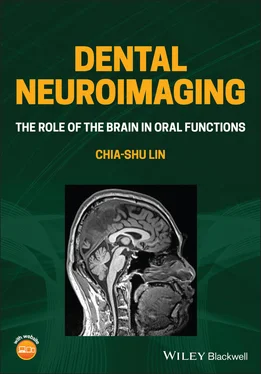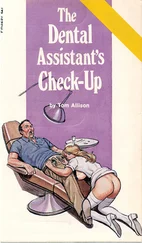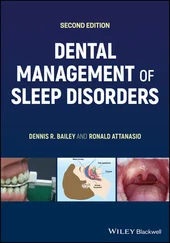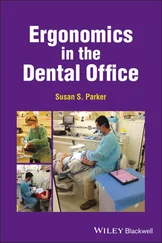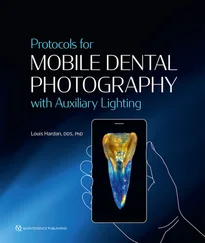Chia-shu Lin - Dental Neuroimaging
Здесь есть возможность читать онлайн «Chia-shu Lin - Dental Neuroimaging» — ознакомительный отрывок электронной книги совершенно бесплатно, а после прочтения отрывка купить полную версию. В некоторых случаях можно слушать аудио, скачать через торрент в формате fb2 и присутствует краткое содержание. Жанр: unrecognised, на английском языке. Описание произведения, (предисловие) а так же отзывы посетителей доступны на портале библиотеки ЛибКат.
- Название:Dental Neuroimaging
- Автор:
- Жанр:
- Год:неизвестен
- ISBN:нет данных
- Рейтинг книги:4 / 5. Голосов: 1
-
Избранное:Добавить в избранное
- Отзывы:
-
Ваша оценка:
- 80
- 1
- 2
- 3
- 4
- 5
Dental Neuroimaging: краткое содержание, описание и аннотация
Предлагаем к чтению аннотацию, описание, краткое содержание или предисловие (зависит от того, что написал сам автор книги «Dental Neuroimaging»). Если вы не нашли необходимую информацию о книге — напишите в комментариях, мы постараемся отыскать её.
Provides the latest neuroimaging-based evidence on the brain mechanisms of oral functions Dental Neuroimaging: The Role of the Brain in Oral Functions
Dental Neuroimaging: The Role of the Brain in Oral Functions
Dental Neuroimaging — читать онлайн ознакомительный отрывок
Ниже представлен текст книги, разбитый по страницам. Система сохранения места последней прочитанной страницы, позволяет с удобством читать онлайн бесплатно книгу «Dental Neuroimaging», без необходимости каждый раз заново искать на чём Вы остановились. Поставьте закладку, и сможете в любой момент перейти на страницу, на которой закончили чтение.
Интервал:
Закладка:
Cerebral diseases, for example, insanity, softening of the brain, tumors and inflammation may produce odontalgia, but clinical reports reveal comparatively few, inasmuch owing to their obscurity positive diagnosis is often rendered difficult.
(Hayes 1889)
Though not scientifically accurate from the modern view, the statement points out the complex association between the brain and orofacial pain, which has confused dentists for more than one century. The alliance becomes cemented due to the challenge of treating orofacial pain, and new technologies, including neuroimaging, have provided new insights into this field (see Chapter 6). Our second evidence comes from the issues of infection control, especially the brain abscess secondary to dental infection. At present, dentists have been highly aware of infection control within the oral cavity. However, new challenges have emerged, such as the recent debates on the neuroinflammatory mechanisms that may underlie the link between neurodegenerative disorders and periodontal diseases (see Chapter 7). Finally, the third evidence of the old alliance has an even longer history. Back in 1790, when the terms ‘brain science’ and ‘dentistry’ have not yet popularized, in an article entitled ‘ Pathological Observations on the Brain ’, the author reported a potential association between epileptic signs and symptoms and irregular behaviour in eating and drinking (Anderson 1790). The finding echoes the link between the brain and oral sensorimotor functions, extensively studied in animal research (Lund 1991). New issues have emerged in modern days. For example, can older individuals be benefited from oral functional training to improve mastication and swallowing (Sessle 2019)? Can patients with neurodegenerative disorders, who have deficits in mental functions, also improve their oral functions? There are more challenges to meet for the old alliance between dentistry and brain science.
1.1.3 Dental Education: The Role of Neuroscience and the Brain
In the previous section, we have briefly discussed how the research of the brain has been linked to issues of oral health. However, the discussion may not be complete without looking into dental education for the following questions: has the role of brain science been recognized in dental education?
1.1.3.1 The Tradition of ‘Dentists as Surgeons’
A discussion of early dental education will not be complete without mentioning the contribution from Pierre Fauchard, widely recognized as the Father of Modern Dentistry, with the first textbook of dentistry Le Chirurgien Dentiste (‘ The Surgeon Dentist ’) published in 1728. As the name suggests, dentistry is the discipline of managing dental diseases with a surgeon's training. Notably, in this book, Fauchard has extended the professional domain of dentists from ‘teeth’ to the oral cavity (including the soft tissue). The new profession, a ‘surgeon dentist’, is different from a ‘toothpuller’ in the seventeenth to eighteenth centuries (Lynch et al. 2006). Though he also emphasized the relationship between oral and systemic diseases (Lynch et al. 2006), the primary task for dentists is to fix the structural deficits of the oral cavity, such as restoring a decayed tooth or replacing the missing teeth with a denture. All the jobs require dentists to be capable of performing complicated surgical skills.
An over‐focus on the surgical skills of dental treatment, however, had gradually received criticism since the early days when dental education became an independent discipline. As pointed by Eugene Talbot early in 1900:
The result is that study of the general diseases which affect the mouth, jaws and teeth have been neglected. Limitations of a dental education have prevented the dentist from associating local diseases with systemic causes.
(Talbot 1900)
The statement corresponds to the degree delivered for this new profession, namely Doctor of Dental Surgery (DDS), at Talbot's time. He further showed the concern that ‘… the graduate of dental surgery is not competent to associate systemic diseases with their effects on the teeth, nor is he capable of appreciating systemic lesions due to overtreatment of pathologic conditions of the teeth’ (Talbot 1900). The gap between a dentist and medical knowledge would make dentists ignore the systemic condition of patients – moreover, the ignorance may further exacerbate systemic health when dentists ‘overtreat’ patients (Talbot 1900).
1.1.3.2 Brain and Neuroscience: Is It Neglected in Dental School?
According to the Basic Science Survey Series of the American Dental Education Association (ADEA), neuroscience is widely taught in most dental schools in North American. In 2014, among 66 dental schools, 31 (47%) offered neuroscience as a standalone course, with the others integrated the neuroscience topics into other courses (Gould et al. 2014). It is also noteworthy that in most dental schools, the course was delivered by teachers from medical schools, who may not tailor‐make the course for dental students (Gould et al. 2014). The average year of teaching of the teachers is relatively high (23.1 years), suggesting fewer younger teachers are involved in the field (Gould et al. 2014). Critically, the topics to be delivered significantly varied between courses. Some topics, such as the knowledge of cranial nerves, were taught averagely for three hours. In contrast, issues of the neuropathic mechanisms of pain, including nerve regeneration, neuralgia, allodynia and hyperalgesia, were taught less than half an hour (Gould et al. 2014). Topics related to the human brain were taught in most of the courses. Nevertheless, among the 31 independent neuroscience courses, almost half of them focused on neuroanatomy, which emphasizes the knowledge of brain structure rather than the link between the brain and oral functions. This alienation reflects that many courses were taught by personnel outside the dental schools and may not provide what dentists need to know for their clinical careers.
Therefore, for teaching neuroscience and brain science in dental schools, the real challenge is not the time and classes allocated for teaching, but how these materials are taught. Non‐dental school faculties mainly taught the courses, and the topics were less tailored for dentistry. For example, in some syllabi of the neuroscience courses, the issue ‘pain’ is taught alongside somatosensation. Nowadays, we have much evidence showing that pain, as a more generalized cognitive–affective experience, is associated with the brain mechanisms of attention, emotional and cognitive processing (see Chapter 6). In this case, a focus on the brain and mental functions, such as the modulatory effect of attention and cognitive appraisal on pain, should be tailored for dental students since it is highly associated with the clinical management of patients.
1.1.4 The ‘New Engagement’: Modern Cross‐Disciplinary Research of Dentistry and Brain Science
Instead of being a comprehensive textbook on the neurobiology of dentistry, this book aims to outline the ‘new engagement’ between dentistry and brain science, with neuroimaging as a critical approach to bridge the two fields. Here, we discuss the trend of cross‐disciplinary research between dentistry and brain science, according to two brief bibliometric surveys. Firstly, a survey based on PubMed was performed by the keywords ‘dental’ and ‘brain’ and the search was limited to titles and abstracts of the literature (tooth[mesh] OR oral[mesh] OR dental[mesh] OR dentistry[mesh] OR teeth[tiab] OR to oth[tiab] OR oral[tiab] OR dental[tiab] OR dentistry[tiab] AND brain[tiab] ). The findings revealed that by December 2020, 20261 research papers had been documented in PubMed. The number of publications shows a pronounced rise in recent years, which almost doubled within 10 years. For example, between 1980 and 1989, the number of publications n = 1566. This number rose from 1990 to 1999 ( n = 2684) and almost doubled from 2000 to 2009 ( n = 4721). From 2010 to 2019, the number doubled again to n = 9331. As discussed in Section 1.2, the increasing number of publications on the brain topic corresponds to the increasing number of publications on neuroimaging, which has become a pivotal method in studying the human brain.
Читать дальшеИнтервал:
Закладка:
Похожие книги на «Dental Neuroimaging»
Представляем Вашему вниманию похожие книги на «Dental Neuroimaging» списком для выбора. Мы отобрали схожую по названию и смыслу литературу в надежде предоставить читателям больше вариантов отыскать новые, интересные, ещё непрочитанные произведения.
Обсуждение, отзывы о книге «Dental Neuroimaging» и просто собственные мнения читателей. Оставьте ваши комментарии, напишите, что Вы думаете о произведении, его смысле или главных героях. Укажите что конкретно понравилось, а что нет, и почему Вы так считаете.
